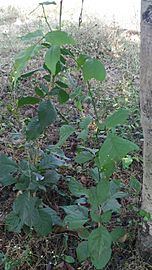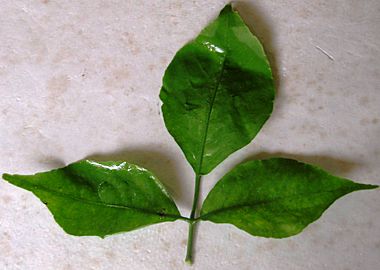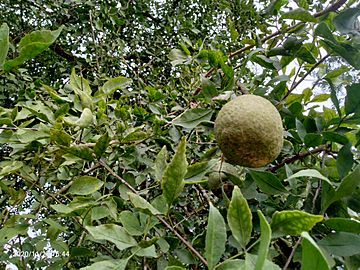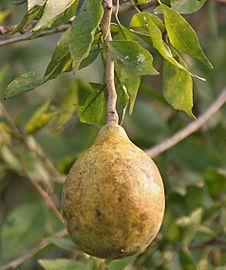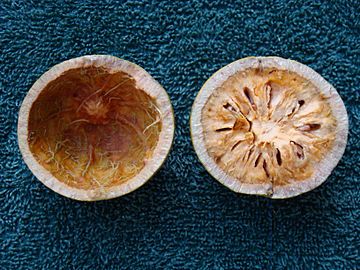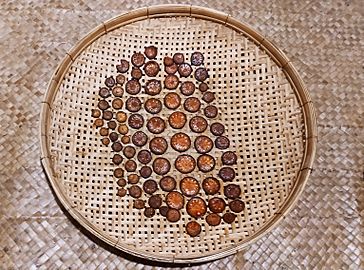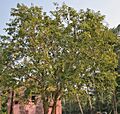Bael facts for kids
Quick facts for kids Bael |
|
|---|---|
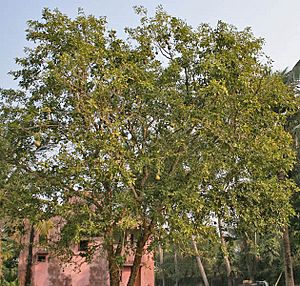 |
|
| Conservation status | |
| Scientific classification | |
| Genus: |
Aegle
|
| Species: |
marmelos
|
| Synonyms | |
|
|
The bael tree, also known as Aegle marmelos, is a special tree found in places like India, Bangladesh, Sri Lanka, and Nepal. It has many other names too, like Bengal quince, golden apple, Japanese bitter orange, stone apple, or wood apple. This tree is quite rare and is considered sacred by people who follow Hinduism.
Contents
What the Bael Tree Looks Like
The bael tree is a type of tree that loses its leaves every year (called deciduous). It can grow up to 13 meters (about 43 feet) tall. It has thin, hanging branches and a crown that isn't perfectly shaped.
The tree's bark is light brown or grayish. It can be smooth or have small cracks and peels off. The bark has long, straight thorns, usually 1.2 to 2.5 cm (about 0.5 to 1 inch) long, that grow alone or in pairs. Sometimes, a sticky sap oozes out from cuts in the bark. This sap is clear and gummy, like a type of glue. It tastes sweet at first but can then feel a bit irritating in your throat.
The leaves of the bael tree are special because each one is made up of three smaller leaflets. These leaflets are about 5 to 14 cm (2 to 5.5 inches) long and 2 to 6 cm (0.8 to 2.4 inches) wide. They are oval-shaped with a pointed tip and a rounded base. Young leaves are light green or pinkish and a bit fuzzy, while older leaves are dark green and smooth.
The bael flowers are small, about 1.5 to 2 cm (0.6 to 0.8 inches) across. They are pale green or yellowish and smell sweet. These flowers usually grow in small clusters and appear when new leaves are growing.
The fruit of the bael tree is usually 5 to 10 cm (2 to 4 inches) wide. It's round or slightly pear-shaped and has a thick, hard skin that doesn't split open when the fruit ripens. The outside of the fruit is smooth and green or gray, turning yellow when it's fully ripe.
Inside the fruit, there are 8 to 20 sections filled with a sweet-smelling orange pulp. Each section has about 6 to 15 flat, oblong seeds, each about 1 cm (0.4 inches) long. These seeds are covered in fuzzy hairs and are inside a sticky, clear goo that hardens when it dries.
The fruit takes about 11 months to ripen on the tree, usually ready in December. A large bael fruit can be as big as a grapefruit or pomelo. Its shell is so hard that you often need a hammer or machete to crack it open! The yellow pulp inside smells very nice, sometimes described as smelling like roses. It tastes sweet, aromatic, and pleasant, a bit like marmalade mixed with tamarind.
Tree Family
The bael tree is special because it's the only type of tree in its group, called the Aegle genus. This means it's unique and doesn't have any close relatives that are also called Aegle.
Where Bael Trees Grow
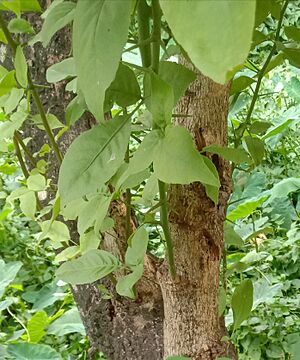
The bael tree originally comes from the Indian subcontinent and Southeast Asia. Today, you can find it growing in many places like Sri Lanka, Thailand, and Malesia.
It likes to grow in dry, open forests on hills and plains, from sea level up to about 1,200 meters (about 3,900 feet) high. It can handle many different types of soil, from acidic to alkaline (with a pH range of 5 to 10). It can also grow in wet soil and can survive in a wide range of temperatures, from very cold -7°C (19°F) to very hot 48°C (118°F). For the fruit to grow well, it needs a clear dry season.
Bael and Nature
The bael tree is important for some butterflies! Its leaves are food for the young caterpillars of two types of Indian swallowtail butterflies: the lime butterfly (Papilio demoleus) and the common Mormon (Papilio polytes).
How People Use Bael
For Eating
Bael fruits are full of vitamin C! You can eat them fresh, or they can be dried and made into sweets like candy or toffee. The pulp can also be turned into powder or a sweet drink called nectar.
If you have a fresh bael fruit, you can strain its juice and add sugar to make a drink similar to lemonade. In some places, like Odisha, India, they make a special drink called Bela pana. This drink mixes the fruit pulp with fresh cheese, milk, water, sugar, crushed black pepper, and ice. One large bael fruit can make a lot of this drink, sometimes five or six liters!
If people want to dry the fruit, they usually slice it and let it dry in the sun. These hard, leathery slices can then be soaked in water later. The young leaves and small shoots of the bael tree are also eaten as salad greens. The fruit pulp is also used to make delicious treats like murabba (a sweet preserve) and puddings.
In Traditional Medicine
In some traditional medicine practices, different parts of the bael tree, like its leaves, bark, roots, fruits, and seeds, are used to try and treat various illnesses. However, it's important to know that there isn't strong scientific proof (called clinical evidence) that these traditional methods are safe or actually work.
Bael in Culture
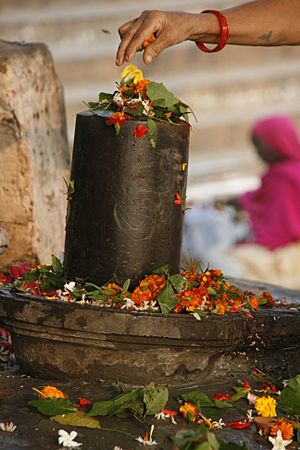
The bael tree is very important in Hinduism. It's considered one of the sacred trees. Ancient Hindu texts, like the Shri Shuktam from the Rig Veda, mention the bael tree as the home of the goddess Lakshmi, who represents wealth and good fortune. Many Hindus believe that bael trees are a form of the goddess Sati.
You can often see bael trees near Hindu temples and in people's home gardens. It's believed that the Hindu god Lord Shiva loves bael trees, and their leaves and fruit are still a big part of his worship. This is because the bael leaf has three parts, which reminds people of Shiva's trident.
In the Newar culture of Nepal, which has Hindu and Buddhist traditions, the bael tree is part of a special fertility ceremony for girls called the Bel Bibaaha. In this ritual, girls are "married" to a bael fruit. The belief is that as long as this fruit is kept safe and doesn't crack, the girl can never truly become a widow, even if her human husband passes away. This tradition helps keep the status of widows high in the Newar community compared to other women in Nepal.
Images for kids
See also
 In Spanish: Aegle marmelos para niños
In Spanish: Aegle marmelos para niños




